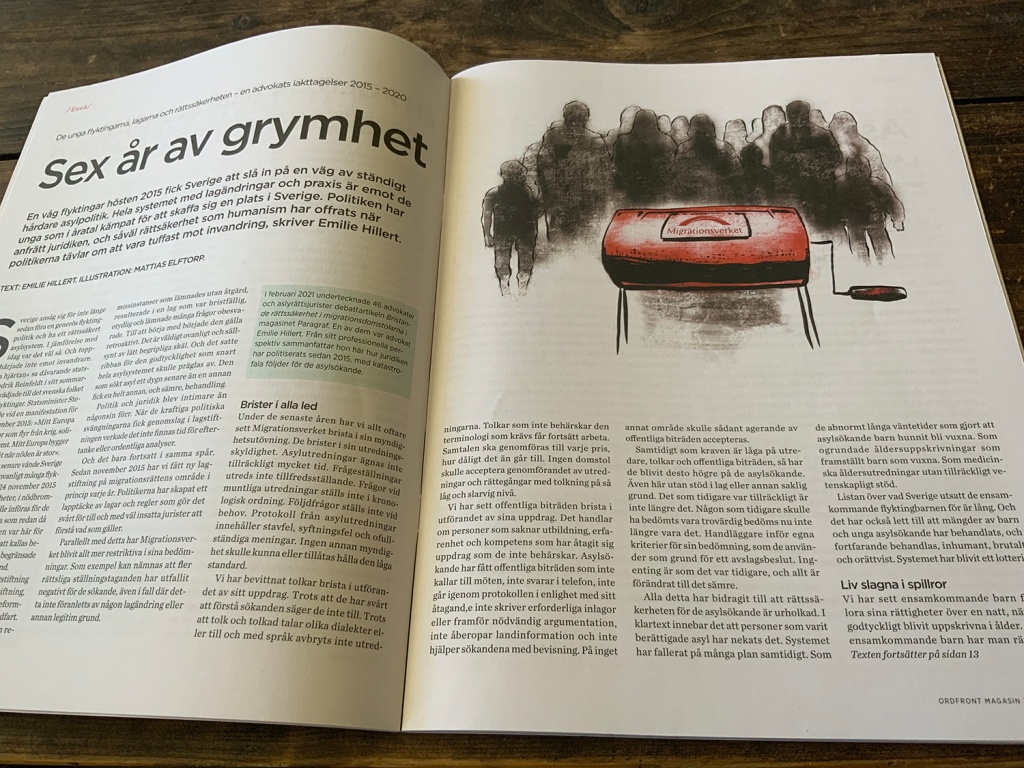My latest published work is an illustration in Ordfront Magasin #3/2021, a special issue about the current state of migration policies in Sweden.

The title of the article translates as “Six years of cruelty”, which refers to the changed policies since the “Syrian refugee crisis” back in 2015. Earlier that year, the Swedish prime minister said that he wants to live in a Europe that is open and helpful when people are in need. In the fall, after a few months of massive refugee immigration, he chose to close the borders. They also “temporarily” stopped most permanent permits of residence, while temporary permits are the norm, along with other restrictions making it harder to pass an application for asylum. “Temporarily” in quotations, because that rule is still active 6 years later and we’re not expected to be going back to normal for a while, if ever. A new law that was passed June 22 of 2021, they made things even harsher. For example, they now have a list of “safe countries” from which asylum applications can be denied with a minimum of deliberation. Which would be hard to combine with the rule that you need individual cause when you apply, but I guess it’s easy if the main goal is to deny asylum for as many as possible and everything else is secondary.
So let’s talk about the normal. Because I’ve seen this 6 year thing mentioned a few times now, and it always bugs me. The text goes on to describe how the whole asylum process has become worse. How asylum decisions are arbitrary, how translators sometime don’t even know the language they’re supposed to interpret but the interviews carry on anyway, how cases are decided without even being thoroughly researched, how lawyers who are supposed to represent the interests of asylum seekers don’t take their jobs seriously etc etc. And I’m sure things have become much worse after the laws were changed BUT all these things were true even before 2015.
I understand the need to really look at the current situation and look at how the laws and practices have become much worse in the last few years. But I also think there is a danger in pretending that if we just go back to the situation as it was in 2014, things would be good again. Because they weren’t.
The illustration I made, representing the migration process as a sort of lottery, was inspired not by what’s happened recently but by how it’s been as far back as I’ve had any kind of insight into the whole thing.
Twenty years ago, we protested against the “refugee storage facilities” (flyktingförvar), as detention centres for asylum seekers are dehumanizingly called in Swedish. People had to hide refugees who weren’t allowed to stay but were desperate not to go back to where they came from. Refugee children were apathetic and mentally unreachable from hopelessness and fear. We were protesting what was called Fortress Europe. Sweden sent money and personnel to Frontex, the EU joint border patrol project designed to keep the unwanted out of Europe. Scientifically dubious age assessments were used to deem children to be older than 18 in order to be able to deport them easier without having to (on paper) violate any UN conventions.
Ten years ago, we were protesting mass deportations to Iraq and Afghanistan, basically active warzones. Palestinians who has been without a country to return to, in some cases for their entire lives, were hungerstriking outside the Swedish Migration Agency in hopes that they would be listened to and finally be allowed to have a place to call home. Various government agencies were cooperating with the Police to hunt for undocumented immigrants in special projects that used racial profiling to find the ones they were looking for.
And none of these things are over. None of them are things of the past, even if the names and methods change slightly, but they are also not things of only these last seven years of even more monstrous policies. And if this is how we treat refugees, it’s gonna be even worse for non-refugee migrants.
The neofascist/ultra conservative/nationalist party Sverigedemokraterna haven’t grown to become Sweden’s third biggest party as a response to Sweden being overrun by hordes of foreign rapists, as they would describe it. They’ve grown in a climate where the “normal” parties have pursued increasingly restrictive migration policies for the last 30 years or so, lending normalcy to anti-immigrant sentiments simply by realizing those sentiments through laws and governmental praxis.
Arbitrary and legally insecure are definitely words to describe the current state of the migration system, and it needs to change. As it has been for a long time, it’s just extra worse right now.
Anyway, if you want to know more (and if you read Swedish), go get the latest issue of Ordfront Magasin. Even if the “six years” rhetoric makes me angry, it is something that needs to be talked about from perspectives other than the currently dominating “immigrants are the cause of all crime and terrorism and all the other bad things” delusion.

